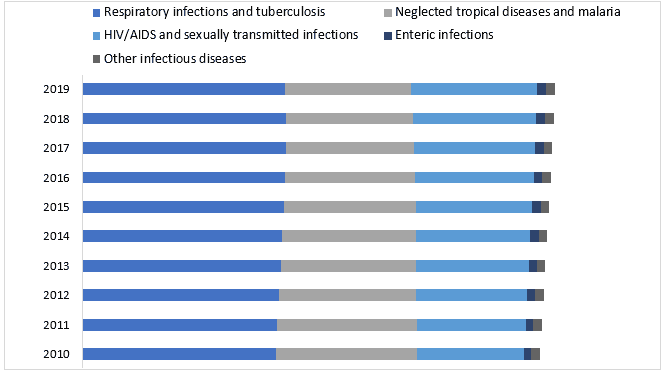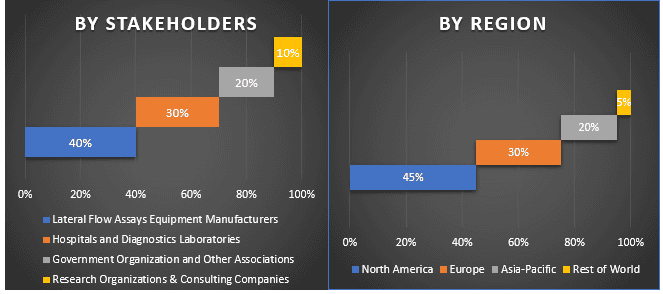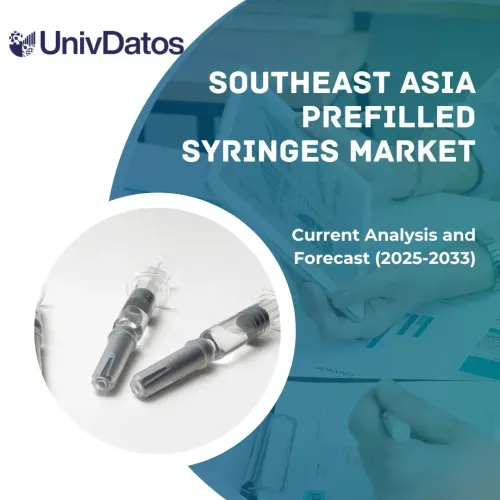- Home
- About Us
- Industry
- Services
- Reading
- Contact Us
Lateral Flow Assay Market: Current Analysis and Forecast (2021-2027)
Emphasis on Product (Kits & Reagents, Lateral Flow Readers); Application (Clinical Testing, Veterinary Diagnostics, Food Safety & Environment Testing, Drug Development, Quality Testing); Technique (Sandwich Assays, Competitive Assays, Multiplex Detection Assays); End-Users (Hospitals & Clinics, Diagnostics Laboratories, Home Care, Pharmaceutical & Biotechnology Companies, Others); Region/Country

Global Lateral Flow Assays Market is anticipated to grow with an elevated CAGR of around 5% over the forecast period (2021-2027). Lateral flow assays are simple paper-based devices that are used for medical diagnostics either for home testing, point of care testing, or laboratory use. They are intended to detect the presence (or absence) of a target analyte in liquid sample (matrix) without the need for specialized and costly equipment.
Infectious diseases are mostly caused by organisms such as bacteria, viruses, parasites, or fungi. Some of the most common infectious diseases are chickenpox, TB, influenza, hepatitis, measles, HIV/AIDS among others. In 2019, nearly 38 million people were affected by the disease HIV/AIDS. Also, in 2020, an estimated 10 million people fell ill with tuberculosis (TB) worldwide. 5.6 million men, 3.3 million women and 1.1 million children, as per the WHO. Owing to these alarming facts and increasing mortality rates across the globe the demand for lateral flow assay testing is increasing rapidly. Thereby, boosting the growth of this market.
Furthermore, the lateral flow assays market is anticipated to grow on account of the growing technological advancement and frequent product launches. For example, in June 2021, Novacyt launched two COVID-19 antigen lateral flow tests by expanding its COVID-19 product portfolio. The company introduced Pathflow COVID-19 rapid antigen and PathFLow COVID-19 rapid antigen pro tests. Furthermore, the increase in usage of home-based lateral flow devices owing to the factors such as portability, compactness, and rapid interpretation of results are also some of the prominent reasons contributing towards the market growth.
Prevalence of Various Infectious Diseases Worldwide (Number), 2010-2019
Abbott Laboratories, F. Hoffman-La Roche Ltd., Danaher Corporation, Thermo Fisher Scientific, Inc., Bio-Rad Laboratories, Siemens AG, PerkinElmer Inc., Merck KGaA, Chembio Diagnostic Systems, Inc., Dickinson and Company, are some of the prominent players operating in the lateral flow assays market. Several M&As along with partnerships have been undertaken by these players to facilitate customers with lateral flow assays.
Insights Presented in the Report
“Amongst Product, Kits & Reagents segment holds the major share”
Based on product, the lateral flow assays market is bifurcated into kits & reagents and lateral flow readers. The kits & reagents segment accounted for the largest market share in 2020 it is estimated that it will exhibit the highest CAGR during the forecast period owing to the increasing usage of various reagents and kits owing to the growing popularity of rapid diagnostics test. Furthermore, the frequent product launches by the major industry players is also anticipated to boost the growth of this segment. However, the lateral flow readers is also expected to grow at a lucrative CAGR during the projected timeframe.
“Amongst Application, Clinical Testing segment holds the major share”
Based on application, the lateral flow assays market is segmented into clinical testing, veterinary diagnostics, food safety & environment testing, drug development & quality testing. The clinical testing segment occupied the major share of the lateral flow assays market in 2020 and it is expected to grow with substantial CAGR in the upcoming years. The growth of this segment is attributed to growing awareness regarding clinical testing owing to the growing prevalence of chronic and infectious diseases all over the globe.
“Amongst Technique, Sandwich Assays segment holds the major share”
Based on technique, the market is fragmented into sandwich assays, competitive assays, and multiplex detection assays. In 2020, sandwich assays segment grabbed the considerable market share, and it is expected to grow at the significant CAGR during the forecast period owing to the wide applications of these types of in the clinical testing. Also, the advantages associated with the use of these assays such as higher sensitivity and specificity for larger analytes is also one of the prominent reasons for the growth of this segment.
“Amongst End-Users, Hospitals & Clinincs segment holds the major share”
Based on end-users, the market is fragmented into hospitals & clinics, diagnostics laboratories, home care, pharmaceutical & biotechnology companies, and others. In 2020, hospitals & clinics segment grabbed the considerable market share, and it is expected to grow at the significant CAGR during the forecast period as most of the population across the globe rely on these long-term facilities for the diagnosis, treatment and management of diseases. Also, the growing number of hospitals and the presence of the latest diagnostics technologies at these places is also one of the reason contributing towards the growth of this segment.
“North America represents one of the largest markets of Lateral Flow Assays market”
For a better understanding of the market dynamics of the lateral flow assays market, a detailed analysis was conducted for different regions across the globe including North America (the U.S, Canada, and the Rest of North America), Europe (Germany, France, Spain, United Kingdom, Italy, and Rest of Europe), Asia-Pacific (China, India, Australia, Japan, and Rest of APAC), Rest of World has been conducted. North America constitutes a major market for the lateral flow assays market industry and generated revenue of USD XX Million in 2020 owing to strong healthcare infrastructure and growing adoption of rapid diagnostics testing kits in the region.
Reasons to buy this report:
- The study includes market sizing and forecasting analysis validated by authenticated key industry experts
- The report presents a quick review of overall industry performance at one glance
- The report covers an in-depth analysis of prominent industry peers with a primary focus on key business financials, product portfolio, expansion strategies, and recent developments
- Detailed examination of drivers, restraints, key trends, and opportunities prevailing in the industry
- The study comprehensively covers the market across different segments
- Deep dive regional level analysis of the industry
Customization Options:
The global lateral flow assays market can further be customized as per the requirement or any other market segment. Besides this, UMI understands that you may have your own business needs, hence feel free to connect with us to get a report that completely suits your requirements.
Table of Content
Analyzing the historical market, estimation of the current market, and forecasting the future market of the global lateral flow assays market were the three major steps undertaken to create and analyze the adoption of lateral flow assays in major regions globally. Exhaustive secondary research was conducted to collect the historical market numbers and estimate the current market size. Secondly, to validate these insights, numerous findings and assumptions were taken into consideration. Moreover, exhaustive primary interviews were also conducted, with industry experts across the value chain of the global lateral flow assays market. Post assumption and validation of market numbers through primary interviews, we employed a top-down/bottom-up approach to forecasting the complete market size. Thereafter, market breakdown and data triangulation methods were adopted to estimate and analyze the market size of segments and sub-segments the industry pertains to. Detailed methodology is explained below:
Analysis of Historical Market Size
Step 1: In-Depth Study of Secondary Sources:
Detail secondary study was conducted to obtain the historical market size of the Lateral flow assays through company internal sources such as annual report & financial statements, performance presentations, press releases, etc., and external sources including journals, news & articles, government publications, competitor publications, sector reports, third-party database, and other credible publications.
Step 2: Market Segmentation:
After obtaining the historical market size of the lateral flow assays market, we conducted a detailed secondary analysis to gather historical market insights and share for different segments & sub-segments for major regions. Major segments included in the report as product, technique, application, and end-users. Further country-level analyses were conducted to evaluate the overall adoption of lateral flow assays across the globe.
Step 3: Factor Analysis:
After acquiring the historical market size of different segments and sub-segments, we conducted a detailed factor analysis to estimate the current market size of the lateral flow assay. Further, we conducted factor analysis using dependent and independent variables such as growing prevalence of infectious and chronic diseases propelling the adoption of lateral flow assay. A thorough analysis was conducted for demand and supply-side scenarios considering top partnerships, merger and acquisition, business expansion, and product launches in the Lateral flow assayssector across the globe.
Current Market Size Estimate & Forecast
Current Market Sizing: Based on actionable insights from the above 3 steps, we arrived at the current market size, key players in the Lateral flow assay market, and market shares of the segments. All the required percentage shares split, and market breakdowns were determined using the above-mentioned secondary approach and were verified through primary interviews.
Estimation & Forecasting: For market estimation and forecast, weights were assigned to different factors including drivers & trends, restraints, and opportunities available for the stakeholders. After analyzing these factors, relevant forecasting techniques i.e., top-down/bottom-up approach was applied to arrive at the market forecast about 2027 for different segments and subsegments across the major markets globally. The research methodology adopted to estimate the market size encompasses:
- The industry’s market size, in terms of value (US$) and the adoption rate of lateral flow assays across the major markets domestically
- All percentage shares, splits, and breakdowns of market segments and sub-segments
- Key players in the lateral flow assay market in terms of products offered. Also, the growth strategies adopted by these players to compete in the fast-growing market
Market Size and Share Validation
Primary Research: In-depth interviews were conducted with the Key Opinion Leaders (KOLs) including Top Level Executives (CXO/VPs, Sales Head, Marketing Head, Operational Head, and Regional Head, Country Head, etc.) across major regions. Primary research findings were then summarized, and statistical analysis was performed to prove the stated hypothesis. Inputs from primary research were consolidated with secondary findings, hence turning information into actionable insights.
Split of Primary Participants in Different Regions
Market Engineering
Data triangulation technique was employed to complete the overall market estimation and to arrive at precise statistical numbers of each segment and sub-segment of the lateral flow assays market. Data was split into several segments & sub-segments post studying various parameters and trends in the areas of product, technique, application, and end-users of the lateral flow assays market.
The main objective of the Lateral Flow Assays Market Study
The current & future market trends of lateral flow assays were pinpointed in the study. Investors can gain strategic insights to base their discretion for investments from the qualitative and quantitative analysis performed in the study. Current and future market trends were determined the overall attractiveness of the market at a regional level, providing a platform for the industrial participant to exploit the untapped market to benefit as a first-mover advantage. Other quantitative goals of the studies include:
- Analyze the current and forecast market size of lateral flow assays in terms of value (US$). Also, analyze the current and forecast market size of different segments and sub-segments
- Segments in the study include areas of product, technique, application, and end-users
- Define and analysis of the regulatory framework for the lateral flow assays industry
- Analyze the value chain involved with the presence of various intermediaries, along with analyzing customer and competitor behaviors of the industry
- Analyze the current and forecast market size of the lateral flow assays market for the major region
- Major regions studied in the report include North America, Europe, Asia-Pacific and Rest of the world
- Company profiles of the lateral flow assays market and the growth strategies adopted by the market players to sustain in the fast-growing market
Deep dive regional level analysis of the industry
Related Reports
Customers who bought this item also bought










